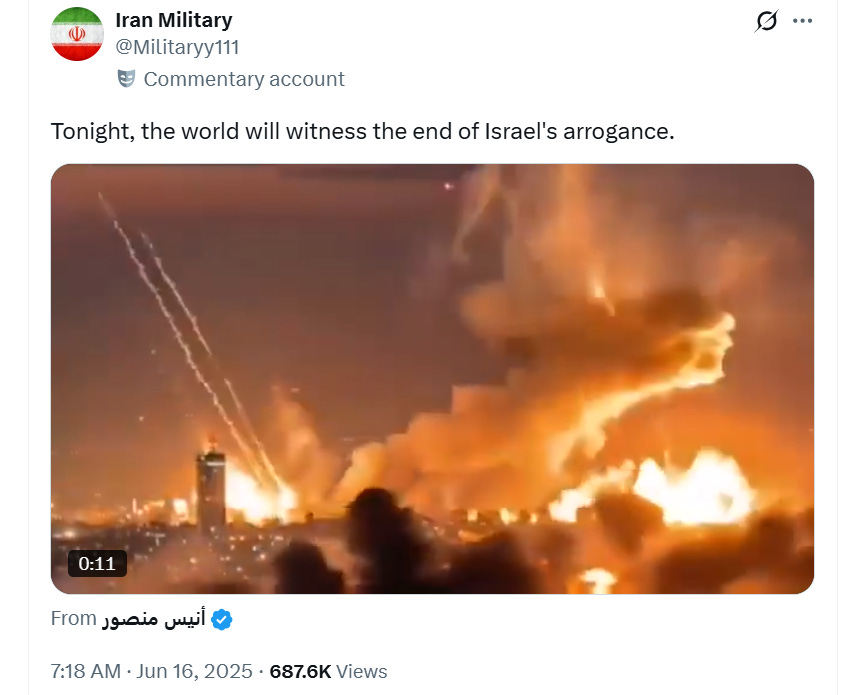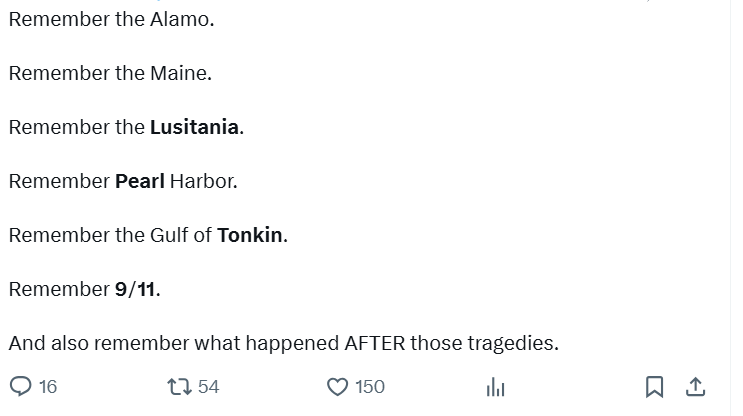USS Nimitz, False Flags & the March to War: How History’s Greatest Deceptions—From Lusitania to 9/11 ...UNENDING WARS
Disclaimer
I am Jon Forrest Little, (a fairly well-known precious metals analyst) This disclaimer discloses I adhere to a strict policy of not commenting on highly volatile and emotionally charged subjects such as abortion, gun rights, the state of Israel, or border issues. My focus remains exclusively on commodity markets and related economic developments.
When my reports mention geopolitical events—such as Iran and Israel exchanging missiles or Iran reportedly considering blocking oil shipments in the Strait of Hormuz—or how US will most likely get duped into joining another war (precisely because USA is controlled by Central bankers who fund the military industrial complex) - all these are referenced strictly within the context of commodity analysis and reporting. My intent is to provide market insights for investors and industry professionals, not to express opinions on sensitive political or social issues.
The Ancient False Flag Playbook of Doom.
Step 1 - Drag some Monstrous Dinosaur of a Target into the Region
Step 2 - Orchestrate an attack on Said Dinosaur
Step 3 - Blame Iran for Bombing US Property
Step 4 - This is the Provocation needed to Go To War Against Iran who is also supported by China, Russia and Pakistan
Below is the Monstrous Dinosaur being prepared to attract an attack to blame on Iran (or it could be the US Embassy located in Israel)
Iran’s official position
US Mainstream Media will mostly report the news from Tel Aviv / Wall Street Perspective when the fact is Israel is being annihilated while Iran vows “to finish them off”
video version below
The False Flag Playbook: From Lusitania to the Nimitz, a History of Manufactured Pretexts
History does not repeat itself, but it rhymes—often in the key of deception. The mechanism of the “false flag” is as old as war itself, yet its modern iterations remain shrouded in plausible deniability, allowing governments to manipulate public opinion and justify military action. From the sinking of the Lusitania to the attacks of 9/11 and beyond, the false flag playbook is a grim testament to how wars are manufactured, not just fought.
The False Flag in Action
A false flag operation is an act committed by one party, disguised to look like the work of another. The term originates from naval warfare, where ships would fly the flag of a neutral or enemy nation to deceive and ambush. Today, it refers to covert operations where a government stages or allows an attack, then pins the blame on a convenient adversary—providing the pretext for war, repression, or financial gain.
Consider the RMS Lusitania. In 1915, the British passenger liner was torpedoed by a German U-boat, killing nearly 1,200 people, including 128 Americans. The incident was a propaganda coup for the Allies, galvanizing American support for entering World War I. Yet, the Lusitania was secretly carrying munitions through a declared war zone, left unprotected by the Royal Navy, and its sinking was cynically exploited to “lie America into war”. The British government actively obstructed investigations for decades, ensuring the myth of German barbarity would endure.
Fast forward to Pearl Harbor. Conspiracy theories abound about whether the U.S. government knew of the impending attack. Historians agree that while American intelligence anticipated war with Japan, the attack on Pearl Harbor was a genuine surprise—not a deliberate sacrifice. However, the shock of the attack was so profound that it became a rallying cry for war, and its legacy is still invoked to justify military vigilance.
9/11 and the War for Resources
The most infamous modern example is 9/11. The attacks were swiftly blamed on Osama bin Laden and al-Qaeda, yet bin Laden himself repeatedly denied responsibility, and the evidence linking him to the attacks remains contested in some circles. Regardless, 9/11 became the pretext for the invasion of Iraq—a war justified by false claims of weapons of mass destruction and ties to terrorism. The real prize? Iraq’s oil and gold reserves, and the opportunity to reshape the Middle East in the interests of Western powers and their financial backers.
The U.S. invasion of Iraq was accompanied by one of the largest cash airlifts in history—$12 billion in shrink-wrapped $100 bills, much of which vanished into the hands of contractors and corrupt officials. The chaos of war created a feeding frenzy for war profiteers, from arms manufacturers to reconstruction firms. As the old adage goes: all wars are bankers’ wars. Banks profit from the debt, the commissions, and the reconstruction contracts, while the public bears the cost in blood and treasure.
The Nimitz: A Giant, Aging Target
Now, consider the USS Nimitz. This 50-year-old aircraft carrier, set to be retired, is a relic of American naval might—and a fat, juicy target for those seeking to manufacture a crisis. The Nimitz is currently operating in the Western Pacific, but its presence in the Middle East has been a recurring theme in recent years, especially amid tensions with Iran. An orchestrated attack on the Nimitz—whether by rogue actors, proxy forces, or even a staged incident—could be blamed on Iran, providing the U.S. with the perfect excuse to escalate hostilities.
The scenario is eerily familiar: a high-profile, symbolic target is attacked, the blame is swiftly assigned to a geopolitical rival, and the drums of war begin to beat. The recent Iranian missile strike near the U.S. Embassy in Tel Aviv—which caused minor damage but no casualties—could be a harbinger of things to come. Reports of Iranian aggression against U.S. assets in Israel are already circulating, and the stage is set for a narrative that justifies military intervention on behalf of Israel, whose interests are increasingly intertwined with those of Wall Street and the fiat currency system.
Trump, the Strongman, and the Walls Closing In
At home, the political landscape is equally combustible. Donald Trump, a failed president by many accounts, is facing unprecedented opposition. On Saturday, up to 7 million people attended nationwide protests against his policies, while his military parade—sponsored by Lockheed Martin, Coinbase, and other corporate interests—drew a crowd more befitting a farmers’ market in the Hamptons than a show of national unity. Trump’s ego and desperation for power are palpable, and history teaches us that this is when strongmen become most dangerous.
When a leader’s back is against the wall, the temptation to manufacture a crisis—to distract, to rally support, to cling to power—becomes overwhelming. The playbook is clear: create or exploit an incident, blame the enemy, and let the war machine do the rest. The public, reeling from shock and fear, is all too willing to follow.
Conclusion: War as a Racket
The false flag is not just a tactic; it is a symptom of a deeper pathology. Wars are not fought for noble causes, but for profit, power, and the perpetuation of the financial system that feeds off them. From the Lusitania to 9/11 to the looming shadow over the Nimitz, the pattern is clear. The next time you hear reports of an attack on a U.S. asset—especially in a volatile region—ask yourself: who stands to gain? And remember, in the game of war profiteering, everyone jumps in to feed—except the people who pay the price.
What is Operation True Promise 3 according to Iran’s point of view?
Operation True Promise 3 marks a dramatic escalation in the longstanding conflict between Iran and Israel. Launched in June 2025, it is Iran’s most forceful retaliatory operation to date, responding directly to Israeli airstrikes—codenamed Operation Rising Lion—that killed top Iranian military commanders and scientists. The IRGC unleashed hundreds of ballistic missiles and drones targeting Israeli cities, including Tel Aviv, Jerusalem, and Haifa, aiming to overwhelm Israel’s air defenses and deliver what Iran described as a “crushing and precise response” to Israeli aggression. The operation’s religious and nationalist symbolism, encapsulated in the battle cry “Ya Ali ibn Abi Talib,” is designed to boost public morale and demonstrate Iran’s military resolve. The strikes have led to civilian injuries, widespread alarm, and a near state of war, raising fears of broader regional conflict and global economic disruption.
This latest phase of Operation True Promise is not just a military campaign but a strategic gambit: Iran seeks to avenge its losses, deter further Israeli strikes, and signal its readiness for war to allies and adversaries alike. The operation’s scale and intensity have pushed the region to the brink, with both sides exchanging attacks and the risk of international escalation growing by the day. As missiles continue to fly and sirens sound across Israeli cities, the world watches anxiously, aware that the next false flag or miscalculation could ignite a far wider conflagration.
All of these missiles and unending wars are a stark reminder of how quickly manufactured crises or retaliatory strikes can spiral out of control, especially when leaders are desperate, alliances are tested, and the machinery of war is already in motion. It is a textbook example of how a cycle of violence, once set in motion, becomes its own justification—fueling the very conflicts that profit the war industry and its financial backers.







